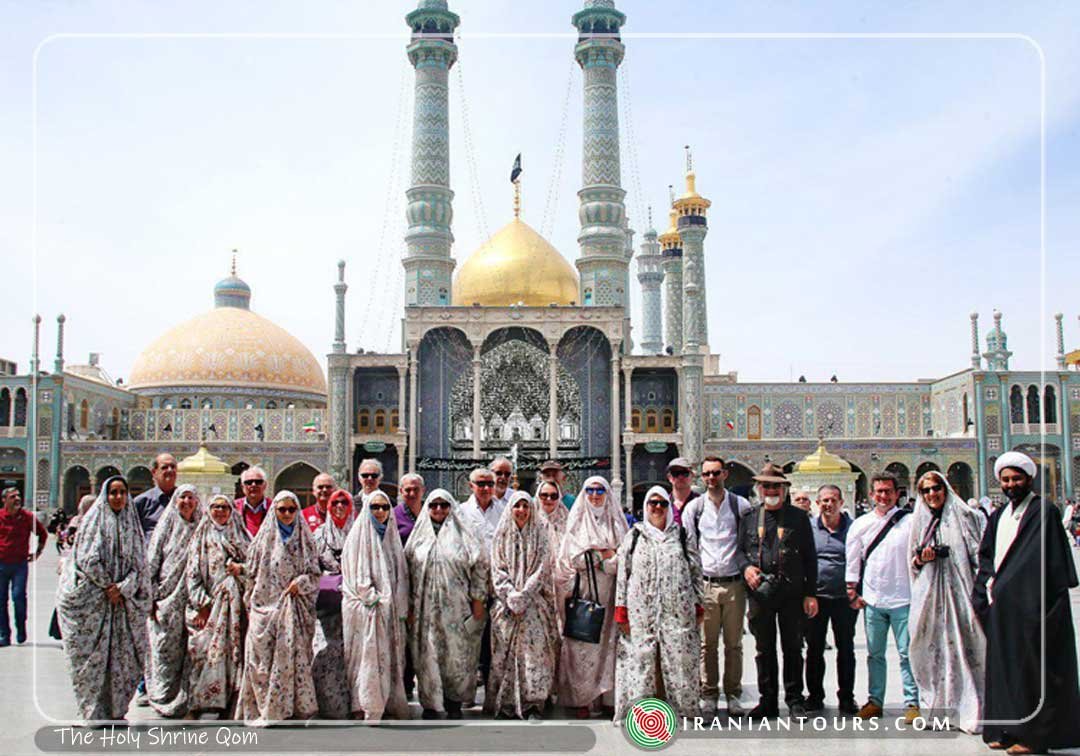The Holy Shrine of Fatimah Masumeh
The Shrine of Fatima Masumeh is located in Qom, which is considered by Shia Muslims to be the second most sacred city in Iran after Mashhad. Fatima Masumeh was the sister of the eighth Imam Reza and the daughter of the seventh Imam Musa al-Kadhim. In Shia Islam, women are often revered as saints if they are close relatives to one of the Twelve Imams. Fatima Masumeh is therefore honoured as a saint, and her shrine in Qom is considered one of the most significant Shi’i shrines in Iran. Every year, thousands of Shi’i Muslims travel to Qom to honour Fatima Masumeh and ask her for blessings. Also buried within the shrine are three daughters of the ninth Twelver Shī‘ah Imām Muhammad al-Taqī.
The mosque consists of a burial chamber, three courtyards and three large prayer halls, totalling an area of 38,000 m2 (410,000 sq ft). The three prayer halls are named: Tabātabā’ī, Bālā Sar, and A‘dham.
Though Shi’i theology formally states that the relatives of the Imams, or imamzadehs, hold a lower status than the Imams, popular Shi’ism still strongly venerates imamzadehs. In Iran, there are many more burial places of the Imams’ relatives than there are for the Imams themselves. Imamzadehs are considered to be close to God and religiously pious because of their close relation to Imams. Shi’is commonly travel on pilgrimages to shrines of imamzadehs, such as the Shrine of Fatima Masumeh, the sister of the 8th Imam ‘Ali al-Rida, in Qom, Iran. Men and women seek cures to ailments, solutions to problems, and forgiveness of sins at these sites. Many hadiths, or teachings, are recorded from Shi’i Imams praising the veneration of Fatima Masumeh, and proclaiming that those who make a pilgrimage to her Shrine will “certainly be admitted to heaven.”
Fatima Masumeh’s Shrine in Qom is crowded every day of the year with Shi’i men, women, and children from all around the world. Some stay for hours or days praying at the mosque and circumambulating her tomb. The economy of Qom has become reliant on this pilgrimage for the tourism it brings. In turn, Qom has remained conservative and traditional to maintain a pious environment for pilgrims. Many miracles have been recorded as taking place at this shrine, and they are documented in a special office within the shrine complex. Some are published in the shrines monthly newspaper, the Payam-e Astan. Pilgrims at the Shrine of Fatima Masumeh follow rituals that have been passed down for centuries. Imam Ali al-Rida, Fatima Masumeh’s brother, outlined these ritual acts as he described the way he visited her Shrine. The prayer Imam al-Rida dictated to his sister continues to be part of the pilgrimage. Since the Safavid period, additional rituals have been added that are now typical for many Shi’i pilgrimages including ritual washing beforehand, dressing in perfumed clothing, and entering the site with one’s right foot.
Since the beginning of Qom’s history in the 7th century, the city has been associated with Shi’ism and set apart from the Sunni caliphate. Many Shi’i hadiths referred to Qom as a “place of refuge for believers,” calling it a deeply religious place. After Fatima Masumeh’s death in Qom and the construction of her Shrine, scholars began to gather in Qom and the city gained its reputation for religious learning. Today, Qom is still noted for its religious seminaries and organizations.
Fatima Masumeh died in Qom in 201 A.H. as she travelled to join her brother, Imam Ali al-Rida in Khorasan. The caravan she travelled in was attacked in Saveh by enemies to the Shi’i’s, and 23 of Fatima Masumeh’s family and friends were killed (Jaffer). Fatima Masumeh was then poisoned by a woman from the enemies, fell ill, and asked to be taken to Qom, where she died. Fatima Masumeh’s host in Qom buried her in his plot of land.
The style of Fatima Masumeh’s Shrine has developed over many centuries. At first, her tomb was covered with a bamboo canopy. Fifty years later, this was replaced by a more durable domed building, at the request of the daughter of Imam Muhammad at-Taqī, Sayyida Zaynab. The family of Sayyida Zainab later added a further two domes to the Shrine. These architectural projects marked the beginning of female patronage of the tomb of Fatima Masumeh.
In 1519, Tajlu Khanum, the wife of Shah Isma’il I, led a project to improve the drainage around the Shrine, embellish the Shrine with an iwan and two minarets, and reconstruct the tomb chamber as a domed octagon. During the Safavid dynasty, the women of this family were very active in embellishing the Shrine of Fatima Masumeh. In times of war, Safavid royal women found refuge in Qom and likely compared their situation to that of Fatima Masumeh. These women donated beautiful fabrics and other items to the Shrine. Shah Abbas I of the Safavids did not patronize the Shrine of Fatima Masumeh as much as he did other shrines of Imams, but he did offer books to the Shrine’s seminary library. Over the years, many Safavids of royal birth were buried close to the Shrine of Fatima Masumeh.
From 1795-1796, Fath-Ali Shah Qajar converted two Safavid Sahn or courtyards into one large courtyard and, in 1803, fixed the golden dome. In 1883, Amin al-Sultan added the new sahn e-jadid or “New Court” to the Shrine complex.






